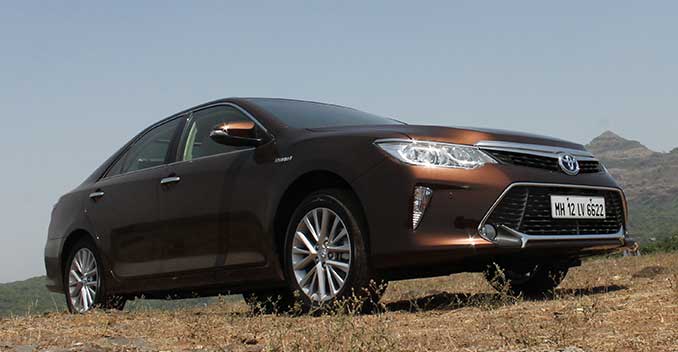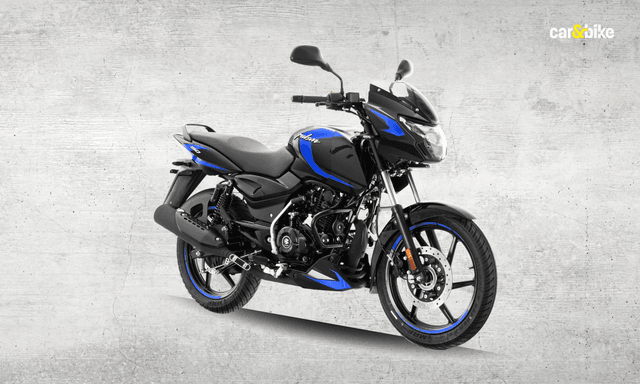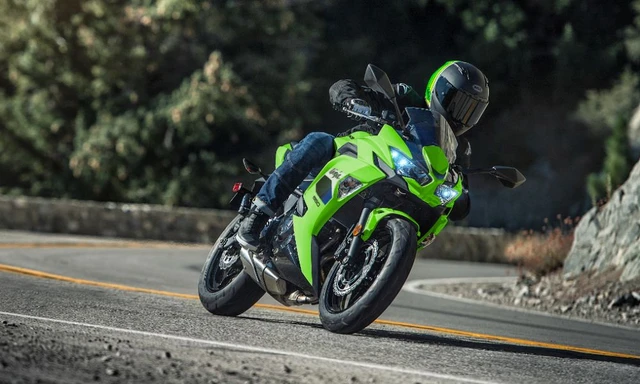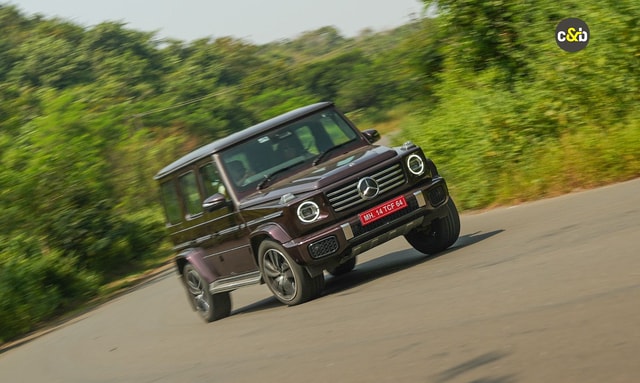Review: Toyota Camry Hybrid Facelift

The Camry was first brought to India in 2002 and since then Toyota has sold 8000 units till date. When I asked how much it sold last year, the prompt answer was around 700 odd units. The surprising bit though was that 73% (532 units) of the cars sold were hybrids while the rest were the conventional petrol lot. The fact that there are more hybrids sold in India, shows that there is a market and that seems to justify why Toyota has brought the facelift of the 7th generation of the Camry to India.
So what is this facelift all about? Well, Toyota has given the new Camry a whole bunch of exterior changes. These include a slimmer front grill and sleek looking headlamps, so it's not at all boring now and looks pretty good. Toyota has also given the Camry LED daytime running lights, while also giving LED main lamps. There is a bit of a bulge on top of the bonnet which gives the front a bit of character, while the massive trapezoidal air dam at the front brings out the wild side of the car. There are changes to the rear as well and overall, the facelift does wonders to the look of the Camry.

However, I have to admit that there's a lot of chrome; probably an overdose of it. The chrome strips run around the chin at the front, the air dam, the door handles, the window sills, the rear and even the tip of the rear bumper. It's all in the name of making it look up market but well, there's a lot.
As we move to the inside of the car, there is a bit of familiarity. There's a lot picked up from the pre-facelift version but none of it feels old fashioned. The centre console is U-shaped and the there's also a new colour information display in the centre of the instrument panel. Thanks to the 3-zone automatic Climate control, the rear seat, as on the previous car, gets its own temperature setting. In fact, the rear seat backs recline up to eight degrees, and is a place to be pampered in.

There have been a whole bunch of changes made to the exterior of the car, but under the hood is the same old affair. Toyota's DOHC VVT-i 2.5-litre petrol unit and the electric motor work together to churn out 202bhp - 158bhp from the petrol motor, and 44bhp from the electric motor. The power split device helps to deliver seamless power to the wheels, and also to the generator that keeps on charging the battery. The battery is nickel metal hydride, unlike the usual lithium-ion, and is placed inside the boot.
There are two driving modes to choose from - EV and Eco. The EV mode kicks in if you're stuck in traffic, as it doesn't allow you to go above 40km/h. If you switch to Eco mode where the electric motor and the petrol engine work hand-in-hand with one another, the hybrid systems jigsaw is solved. The result is that you're immediately transported into an evolved and refined driving experience, not to forget an efficient one.
Then there's the e-CVT (electronically continuously variable transmission), which the engine is mated to and when you floor the accelerator, the revs build up and though delayed, the power delivery is seamless. The torquey petrol engine takes off its gloves and provides immense energy, which truly builds your excitement levels. The ride quality too is refined and Toyota says that they have re-tuned the shock absorbers to help the Camry eat up the bumps on the road. Efficiency wise, Toyota claims that the Camry Hybrid delivers 19.6km/l (ARAI figures), which is truly impressive for a car of this size.
Now, we come down to the price of the car and at Rs. 31.92 lakhs (ex-showroom Delhi) it is pretty steep. In fact it treads on the territory of the luxury car makers like Audi, Mercedes and BMW. This might be a worrying factor for Toyota but the ace up their sleeve is the hybrid system in the car and thanks to the FAME-India scheme (Faster Adoption and Manufacturing of Electric vehicles in India), recently introduced by the Indian government, it will receive a relief of Rs. 70,000 which the car maker will pass on to the customer. Yes, it's expensive but that's the price you pay for luxury, innovations and fuel-saving technology.
Trending News
 10 mins readTata Sierra Review: India’s New Favourite?
10 mins readTata Sierra Review: India’s New Favourite?
Latest News
 car&bike Team | Dec 24, 2025Updated Bajaj Pulsar 150 Launched At Rs 1.09 Lakh: Gets LED Lighting, New ColoursThe Pulsar 150 is offered in three variants with prices topping out at Rs 1.15 lakh (ex-showroom).2 mins read
car&bike Team | Dec 24, 2025Updated Bajaj Pulsar 150 Launched At Rs 1.09 Lakh: Gets LED Lighting, New ColoursThe Pulsar 150 is offered in three variants with prices topping out at Rs 1.15 lakh (ex-showroom).2 mins read Janak Sorap | Dec 24, 20252026 Kawasaki Ninja 650 Launched at Rs 7.91 LakhWith E20 compliance, the 2026 Ninja 650 receive a new colour update and a premium price tag.1 min read
Janak Sorap | Dec 24, 20252026 Kawasaki Ninja 650 Launched at Rs 7.91 LakhWith E20 compliance, the 2026 Ninja 650 receive a new colour update and a premium price tag.1 min read Jafar Rizvi | Dec 24, 2025Listed: Car Manufacturers That Will Hike Prices From January 2026Based on the announcements made so far, the price increase across car models is expected to range between 2 and 3 per cent.3 mins read
Jafar Rizvi | Dec 24, 2025Listed: Car Manufacturers That Will Hike Prices From January 2026Based on the announcements made so far, the price increase across car models is expected to range between 2 and 3 per cent.3 mins read car&bike Team | Dec 24, 2025KTM RC 390 Discontinued Globally, Remains On Sale In IndiaThe KTM RC 390 will continue to be offered on sale in India, where it is manufactured and there’s still strong demand for the model.2 mins read
car&bike Team | Dec 24, 2025KTM RC 390 Discontinued Globally, Remains On Sale In IndiaThe KTM RC 390 will continue to be offered on sale in India, where it is manufactured and there’s still strong demand for the model.2 mins read car&bike Team | Dec 23, 2025India Bike Week 2025 In Pictures: Highlights From Edition 12The 12th Edition of IBW was held on December 19 and 20, and if you missed this year’s festival, here is a recap of all that happened.3 mins read
car&bike Team | Dec 23, 2025India Bike Week 2025 In Pictures: Highlights From Edition 12The 12th Edition of IBW was held on December 19 and 20, and if you missed this year’s festival, here is a recap of all that happened.3 mins read Amaan Ahmed | Dec 23, 2025Tata To Enter Rs 40 Lakh Passenger Car Market With First Avinya Electric SUV In End-2026Set to be one of three EV launches from Tata Motors next year, the first in the Avinya series of electric vehicles will catapult the Pune-based carmaker into uncharted market territory, as it will be the most expensive Tata yet.1 min read
Amaan Ahmed | Dec 23, 2025Tata To Enter Rs 40 Lakh Passenger Car Market With First Avinya Electric SUV In End-2026Set to be one of three EV launches from Tata Motors next year, the first in the Avinya series of electric vehicles will catapult the Pune-based carmaker into uncharted market territory, as it will be the most expensive Tata yet.1 min read
 Jafar Rizvi | Dec 24, 2025MG Windsor EV 38 kWh Long-Term Report: IntroductionThe Windsor EV has joined our garage, and before it settles into daily duty, I took it out to get a sense of what living with an electric car is like.4 mins read
Jafar Rizvi | Dec 24, 2025MG Windsor EV 38 kWh Long-Term Report: IntroductionThe Windsor EV has joined our garage, and before it settles into daily duty, I took it out to get a sense of what living with an electric car is like.4 mins read Seshan Vijayraghvan | Dec 23, 20252026 Kia Seltos Review: Formula Is Spot On, But Is The Timing Right?The 2nd-gen Kia Seltos has arrived, but it has the challenge of facing strong rivals like the Victoris and Sierra. The question is simple - Does it still have what it takes?9 mins read
Seshan Vijayraghvan | Dec 23, 20252026 Kia Seltos Review: Formula Is Spot On, But Is The Timing Right?The 2nd-gen Kia Seltos has arrived, but it has the challenge of facing strong rivals like the Victoris and Sierra. The question is simple - Does it still have what it takes?9 mins read Seshan Vijayraghvan | Dec 22, 20252026 Tata Harrier & Safari 1.5 Hyperion Review: By The Power Of Petrol!The new Tata Harrier and Safari petrol packs a new 1.5-litre TGDI Hyperion engine, but is it an ideal alternative to the diesel version?7 mins read
Seshan Vijayraghvan | Dec 22, 20252026 Tata Harrier & Safari 1.5 Hyperion Review: By The Power Of Petrol!The new Tata Harrier and Safari petrol packs a new 1.5-litre TGDI Hyperion engine, but is it an ideal alternative to the diesel version?7 mins read Bilal Firfiray | Dec 19, 2025Maruti Suzuki e-Vitara Review: Worth The Wait?After a long wait, the first-ever electric Maruti Suzuki is here. It’s the e-Vitara, and it comes with a few promises. But arriving this late, is it worth the wait? Or is it a case of too little, too late?9 mins read
Bilal Firfiray | Dec 19, 2025Maruti Suzuki e-Vitara Review: Worth The Wait?After a long wait, the first-ever electric Maruti Suzuki is here. It’s the e-Vitara, and it comes with a few promises. But arriving this late, is it worth the wait? Or is it a case of too little, too late?9 mins read Bilal Firfiray | Dec 18, 2025Mercedes-Benz G450d: The Subtle Power of EvolutionThe Mercedes-Benz G 450d evolves subtly with more power, improved efficiency, and modern tech, while staying true to the timeless G-Class design. And character.4 mins read
Bilal Firfiray | Dec 18, 2025Mercedes-Benz G450d: The Subtle Power of EvolutionThe Mercedes-Benz G 450d evolves subtly with more power, improved efficiency, and modern tech, while staying true to the timeless G-Class design. And character.4 mins read











































































































































